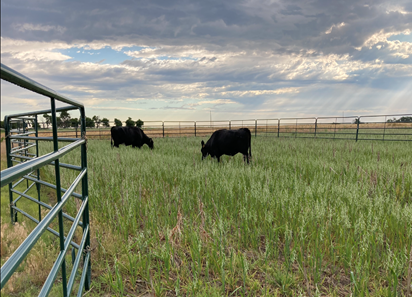Cover Crops
Integrating cover crops (CCs) into dryland crop production in the semi-arid central Great Plains (CGP) can provide several benefits. These include reduced soil erosion, improved nutrient cycling, suppression of herbicide resistant (HR) weeds, enhanced crop profitability and improved soil health. Despite these benefits and grower interest in using CC to improved soil health and suppress HR weeds, CC adoption is slow because CCs utilize water that otherwise would be available to the subsequent cash crop.

Grazing or haying CCs can provide economic benefits to offset revenue loss associated with decreased crop yields when CCs are grown ahead of a cash crop. This approach could provide an opportunity for dryland producers to build soil health and produce harvestable forage for the region’s livestock. Limited information exists on the impacts of utilizing CCs fo
r forage on soil health and crop yields in semi-arid dryland (non-irrigated) systems. This research effort will provide critical and immediate information needed to address producer questions on sustainable use of CCs for forage while maintaining soil health in our climate.
Field experiments are being conducted on Kansas State University experimental fields at Garden City and Hays as well as producer farms across western Kansas to investigate forage production potential, water use, weed suppression and cash crop yield penalties associated with growing CC in place of chem-fallow. Additionally, we will quantify CC management strategy (grazing, haying and standing cover) effects on soil health attributes (SOC, dry & wet aggregate stability, microbial biomass) as well as weed seed bank and population dynamics.
Video, Podcasts, Multimedia
- Obour, A. K., (2021) "Grazing Cover Crops - Powerpoint/Video Presentation"
Digital Journals / Reports
- Obour, A. K.; Simon, L. M.; Holman, J. D.; and Johnson, S. K. (2021) "Does Grazing Cover Crops Impact Soil Properties?," Kansas Agricultural Experiment Station Research Reports: Vol. 7: Iss. 5. https://doi.org/10.4148/2378-5977.8078.
- Johnson, S., J. Brummer, Obour, A. Moore, J. Holman, and M. Schipanski. 2020. Cover crop grown post-wheat for forage under dryland conditions in the High Plains. Kansas State Univ. Agric. Expt. Station & Coop. Ext. Publication no. MF3523. https://bookstore.ksre.ksu.edu/pubs/MF3523.pdf.
- Obour, A. K., J.D. Holman, L.M. Simon, and S.K. Johnson. 2020. Dual use of cover crops for forage production and soil health in dryland crop production. Kansas Agricultural Experiment Station Research Reports: Vol. 6: Iss. 5. https://doi.org/10.4148/2378-5977.7930.
- Simon, L. M. A.K. Obour, J. D. Holman, and K. L. Roozeboom. 2020. Long-term cover crop management effects on soil health in semiarid dryland cropping systems. Kansas Agricultural Experiment Station Research Reports: Vol. 6: Iss. 5. https://doi.org/10.4148/2378-5977.7927.
- Obour, A. K., J. D. Holman, J. A. Dille, and V. Kumar. 2019. Effects of Spring-Planted Cover Crops on Weed Suppression and Winter Wheat Grain Yield in Western Kansas," Kansas Agricultural Experiment Station Research Reports: Vol. 5: Iss. 6. https://doi.org/10.4148/2378-5977.7784
- Obour, A. K., J.D. Holman, and J. R. Jaeger. 2019. Cover Crop Management Effects on Soil Water Content and Winter Wheat Yield in Dryland Systems," Kansas Agricultural Experiment Station Research Reports: Vol. 5: Iss. 6. https://doi.org/10.4148/2378-5977.7785.
- Brummer, J., S. Johnson, Obour, K. Caswell, A. Moore, J. Holman, M. Schipanski, and K. Harmoney. 2018. Managing spring planted cover crops for livestock grazing under dryland conditions in the high plains region. Colorado State Univ. Coop. Ext. Fact Sheet No. 0.309. http://extension.colostate.edu/topic-areas/agriculture/managing-spring-planted-cover-crops-for-livestock-grazing-under-dryland-conditions-in-the-high-plains-region-0-309/